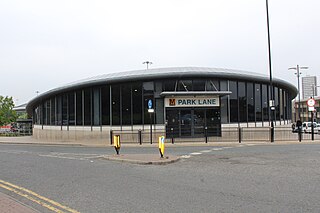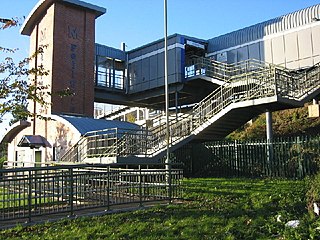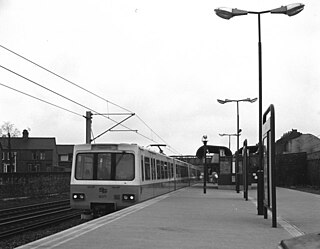
The Tyne and Wear Metro is an overground and underground light rail rapid transit system serving Newcastle upon Tyne, Gateshead, North Tyneside, South Tyneside, and the City of Sunderland. The network opened in stages from August 1980 and now serves a total of 60 stations, with two lines covering 77.5 km (48.2 mi) of track. The Metro can be accessed from a mixture of under ground and above ground stations. It has been described as the "first modern light rail system in the United Kingdom". The system is currently owned and operated by the Tyne and Wear Passenger Transport Executive, thus is fully under public ownership and operation.

The Durham Coast Line is an approximately 39.5-mile (63.6 km) railway line running between Newcastle and Middlesbrough in North East England. Heavy rail passenger services, predominantly operated Northern Trains, and some freight services operate over the whole length of the line; it provides an important diversionary route at times when the East Coast Main Line is closed. Light rail services of the Tyne and Wear Metro's Green Line also operate over the same tracks between a junction just south of Sunderland station and Pelaw Junction.

Millfield is a Tyne and Wear Metro station, serving Sunderland Royal Hospital and the suburb of Millfield, City of Sunderland in Tyne and Wear, England. It joined the network on 31 March 2002, following the opening of the extension from Pelaw to South Hylton.

Heworth Interchange consists of a National Rail, Tyne and Wear Metro and bus station. It is located in the suburb of Heworth, Gateshead in Tyne and Wear, England, and opened on 5 November 1979 for rail and bus services. The station joined the Tyne and Wear Metro network around two years later, on 15 November 1981.

Park Lane is a Tyne and Wear Metro station, serving the port city of Sunderland in Tyne and Wear, England. It joined the network on 28 April 2002, following the opening of the extension from Pelaw to South Hylton.

Tyne Dock is a Tyne and Wear Metro station, serving South Tyneside Hospital and the suburb of Tyne Dock, South Tyneside in Tyne and Wear, England. It joined the network on 24 March 1984, following the opening of the fifth phase of the network, between Heworth and South Shields.

Fellgate is a Tyne and Wear Metro station, serving the suburbs of Fellgate and Hedworth, South Tyneside in Tyne and Wear, England. It joined the network on 31 March 2002, following the opening of the extension from Pelaw to South Hylton.

East Boldon is a Tyne and Wear Metro station, serving the villages of Cleadon and East Boldon, South Tyneside in Tyne and Wear, England. It joined the network on 31 March 2002, following the opening of the extension from Pelaw to South Hylton.

Sunderland is a railway and metro station in Sunderland, Tyne and Wear, England. It is on the Durham Coast Line, which runs via Hartlepool and the city between Middlesbrough and Newcastle. It is owned by Network Rail and managed by Northern Trains. Since 31 March 2002, the station has also been served by the Tyne and Wear Metro's Green Line.

University is a Tyne and Wear Metro station, serving the University of Sunderland and suburb of Ashbrooke, City of Sunderland in Tyne and Wear. It joined the network on 31 March 2002, following the opening of the extension from Pelaw to South Hylton.

South Hylton is a Tyne and Wear Metro station, serving the suburbs of Pennywell and South Hylton, City of Sunderland in Tyne and Wear, North East England. It joined the network as a terminus station on 31 March 2002, following the opening of the extension from Pelaw to South Hylton.

Seaburn is a Tyne and Wear Metro station, serving the suburbs of Fulwell and Seaburn, City of Sunderland in Tyne and Wear, England. It joined the network on 31 March 2002, following the opening of the extension from Pelaw to South Hylton.

Gateshead Interchange is a Tyne and Wear Metro station, serving the town of Gateshead in Tyne and Wear, England. It joined the network on 15 November 1981, following the opening of the third phase of the network, between Haymarket and Heworth.

Hebburn is a Tyne and Wear Metro station, serving the town of Hebburn, South Tyneside in Tyne and Wear, England. It joined the network on 24 March 1984, following the opening of the fifth phase of the network, between Heworth and South Shields.

Regent Centre is a Tyne and Wear Metro station in Zone B, serving the suburb of Gosforth, Newcastle upon Tyne. It joined the network on 10 May 1981, following the opening of the second phase of the network, between South Gosforth and Bank Foot.

Central Station is an underground Tyne and Wear Metro station, serving the Grainger Town area of the city of Newcastle upon Tyne in Tyne and Wear, England. It joined the network on 15 November 1981, following the opening of the third phase of the network, between Haymarket and Heworth. The station is named after Newcastle Central railway station, which stands directly above it.

South Shields railway station was the main railway station for South Shields, in Tyne and Wear, North-East England. The station was located on Mile End Road in the town centre. The station was opened by the NER in 1879 as the terminus of their newly extended Newcastle and South Shields Railway branch from Pelaw via Hebburn and had two platforms and an ornate overall roof.

Pallion is a Tyne and Wear Metro station, serving the suburb of Pallion, City of Sunderland in Tyne and Wear, England. It joined the network on 31 March 2002, following the opening of the Wearside extension – a project costing in the region of £100 million. The station was used by 92,060 passengers in 2017–18, making it the least-used station on the network.

Felling is a Tyne and Wear Metro station, serving the suburb of Felling, Gateshead in Tyne and Wear, England. It joined the network on 15 November 1981, following the opening of the third phase of the network, between Haymarket and Heworth.

Tyne and Wear is a metropolitan area covering the cities of Newcastle upon Tyne and Sunderland, as well as North and South Tyneside, Gateshead and Washington.





















